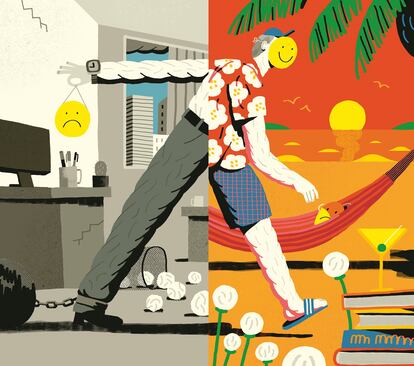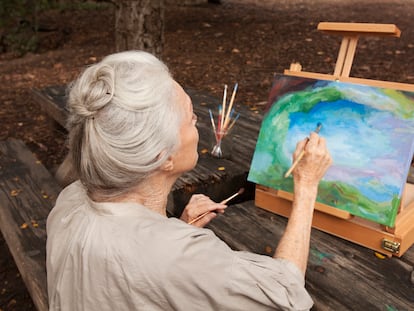Retirement: abyss or dawn? The keys to getting the most out of this vital stage
The end of one’s working life can be a relief but also feel like a threat. It is essential to face mourning for the past and embrace new opportunities

“If it is so difficult to begin, imagine what it will be to end,” as Louise Glück reflected in one of her last poems. This question resonated with me recently when a friend caught me off guard by asking me what I think the last session with my psychoanalysis patients will be like. For many, the decision to retire can come as a relief. For others, it can feel more like a threatening burden. It depends on the factors involved. In a world with low-paid, often unpleasant and unrewarding jobs, retirement is considered highly desirable. But a surprising percentage of people retire unexpectedly, having little or no control over their exit conditions.
The effects of retirement on mental health are a topic of growing concern. In several EU countries, the retirement age has been pushed forward and the generosity of pension protocols has been reduced, because population growth and increasing life expectancy have put enormous pressure on social welfare systems. While reforms that discourage early retirement could contribute to the sustainability of public finances, they also risk worsening the quality of life of retirees.
We hope that retirement will eliminate work-related stress and precarious work environments, that retirees will have more free time and availability to engage in uplifting activities, such as exercise, and to develop their social connections, which would be beneficial for mental health. However, it can also bring significant stressful changes with negative effects: the loss of interaction with co-workers and other contacts, as well as related activities. We leave behind our identity, as it was defined in our jobs: labeled, measured, respected and rewarded by the outside world — although unfortunately this is often not the case. Furthermore, decreased income creates insecurity and requires a readjustment of expectations at a time when, ironically, one is “free” to consider activities such as travel. Consequently, these lifestyle alterations, combined with deterioration of the body and possible poor health, can have negative effects.
The good news is that advancing age tends to bring about a slow and mysterious, but powerful, change in the internal forces that drive us to create. It is very likely that the time limit imposes a pressure, an incentive, that plays a capital role in the creativity of many long-lived artists. How did Matisse manage to avoid falling into the abyss of depression and create his most surprising collages in bed or from a wheelchair, while caring with a certain devotion for his various chronic ailments? Artistic creativity does not prevent the aging of the body, nor does it preserve mental agility or the adventurous spirit. The explanation of the impetuous art of the great creators must be sought elsewhere. What does psychoanalysis say about the origins of this dawn at dusk? Perhaps the key is being able to grieve for lost opportunities and face the perspective of one’s own death, which allows each stage to be experienced as something new.
There is also the inevitable consequence of longevity as an opportunity to experiment and learn. Goya’s drawing I am Still Learning, which dates from his exile in Bordeaux, is a symbolic self-portrait that has become a reference for the octogenarian artist’s spirit that expresses his unwavering desire for personal improvement. Edward Said, a precursor of postcolonial studies, has come to consider it “a late style,” the way in which the work of some great artists acquires a new language towards the end of their lives. And what if age and ill health do not produce the serenity of maturity? This is the case of Ibsen, whose final works tore apart the artist’s career and craft. Far from resolution, they suggest an angry and disturbed artist for whom the dramatic medium provides an occasion to provoke more anxiety and leave audiences more perplexed than ever before. According to Said, the late style here implies “a non-harmonious, non-serene tension and, above all, a kind of deliberately unproductive productivity that goes against it all…”
But the prerogative of those who continue forward is another. Samuel Beckett hit the nail on the head with his “I can’t go on. I’ll go on.” As I advance in age, these reflections lead me to my friend’s question: time, loss, and grief are intrinsic parts of all psychoanalysis, from beginning to end. In the words of the psychoanalyst Jean Laplanche: “The goal of psychoanalysis is to put an end to it so that a new life can begin.”
Sign up for our weekly newsletter to get more English-language news coverage from EL PAÍS USA Edition
Tu suscripción se está usando en otro dispositivo
¿Quieres añadir otro usuario a tu suscripción?
Si continúas leyendo en este dispositivo, no se podrá leer en el otro.
FlechaTu suscripción se está usando en otro dispositivo y solo puedes acceder a EL PAÍS desde un dispositivo a la vez.
Si quieres compartir tu cuenta, cambia tu suscripción a la modalidad Premium, así podrás añadir otro usuario. Cada uno accederá con su propia cuenta de email, lo que os permitirá personalizar vuestra experiencia en EL PAÍS.
¿Tienes una suscripción de empresa? Accede aquí para contratar más cuentas.
En el caso de no saber quién está usando tu cuenta, te recomendamos cambiar tu contraseña aquí.
Si decides continuar compartiendo tu cuenta, este mensaje se mostrará en tu dispositivo y en el de la otra persona que está usando tu cuenta de forma indefinida, afectando a tu experiencia de lectura. Puedes consultar aquí los términos y condiciones de la suscripción digital.
More information
Archived In
Últimas noticias
The late consecration of women artists in their 90s
The Florida Keys tourist paradise is besieged by immigration agents: ‘We’ve never seen anything like this’
The latest scam on WhatsApp behind the legal dream: using immigration status as bait
Oil, gold and rare earth elements: the backdrop to US political tension with Venezuela
Most viewed
- Families demand repatriation of bodies of Colombians who died in Ukraine: ‘This war is a slaughterhouse for foreigners’
- The low-cost creative revolution: How technology is making art accessible to everyone
- Liset Menéndez de la Prida, neuroscientist: ‘It’s not normal to constantly seek pleasure; it’s important to be bored, to be calm’
- Christian Louboutin: ‘Young people don’t want to be like their parents. And if their parents wear sneakers, they’re going to look for something else’
- ‘El Limones’ and the growing union disguise of Mexican organized crime










































